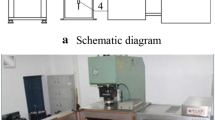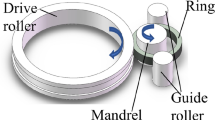Abstract
Intelligent manufacturing is a new mode and trend of sustainable manufacturing development. It optimizes the design and manufacturing process of products and greatly reduces the consumption of resources and energy by virtue of the huge potential of computer modeling and simulation and information communication technology. Under the background of intelligent manufacturing, intelligent bearing is proposed on the basis of traditional bearing products. Intelligent bearing is one of the research and development directions of high-end bearings at home and abroad. Embedded test technology is one of the research fields of intelligent bearings at present. Firstly, based on the finite element model, the structural design problems related to the integration of rolling bearing and sensor are studied. According to the load distribution of bearing, the optimal slot position of bearing is determined. Considering the influence of reducing the bearing capacity, the influence of axial and radial slot ways of bearing outer ring on the maximum deformation and stress of bearing outer ring is studied, and the bearing outer ring is analyzed The relationship between the maximum deformation, maximum stress and the groove size of the outer ring of the bearing is determined to provide the basis for the selection and design of the sensor module. Secondly, according to the friction moment formula, the total heat of the bearing is calculated. Based on the workbench, the temperature field cloud distribution model of the rolling bearing is established to analyze the changes of the speed, the radial load and the temperature of the inner and outer ring of the bearing Finally, according to the slot position and slot size, select the appropriate sensor and rolling bearing integration to achieve the real-time monitoring of the operation state of the bearing.




















Similar content being viewed by others
References
Benmahdi, D., Rasolofondraibe, L., Chiementin, X., Murer, S., & Felkaoui, A. (2019). RT-OPTICS: Real-time classification based on OPTICS method to monitor bearings faults. Journal of Intelligent Manufacturing, 30(5), 2157–2170.
Brian, T.H.-H., & Robert, X. G. (2000). Structural design and analysis for a senor-integrated ball bearing. Finite Elements in Analysis and Design, 34, 257–270.
Holm-Hansen, B. T., & Gao, R. X. (1997). Smart bearing utilizing embedded sensors: Design considerations. The International Society for Optics and Photonics, 3041, 602–610.
Hu, Y., Lin, J., & Andy, C. T. (2019). Failure analysis of gearbox in CRH high-speed train. Engineering Failure analysis, 105, 110–126.
Li, X., Zhang, W., Ding, Q., & Sun, J. (2020). Intelligent rotating machinery fault diagnosis based on deep learning using data augmentation. Journal of Intelligent Manufacturing, 31(2), 433–452.
Liu H. (2006). Research on key technology of intelligent bearing based on embedded sensor. In Changsha: National University of Defense Science and Technology, pp. 24–40.
Liu, X., Wang, W., & Wang, Q. (2015). Temperature field analysis of high speed angular contact ball bearing based on ANSYS. Journal of Modular Machine Tools and Automatic Machining Technology, 48(2), 13–15.
Lu, Q. (2004). Some theoretical analysis of the influence of micro-sensor embedding on the mechanical properties of intelligent bearing structure (pp. 32–48). Shenyang: Northeastern University.
Palmgren, A. (1959). Ball and Roller Bearing Engineering. Burbank: SKF Industries.
Robert, X. G., & Priyranjan, S. (1998). Structure analysis of a sensor module for the “Smart” bearing. Proceedings of the ASME Dynamic Systems and Control Division, 64, 615–621.
Scott S, Kovacs A, Gupta L. (2011). Wireless temperature micro sensors integrated on bearings for the health monitoring applications. In IEEE 24th international conference on micro electro mechanical systems (pp. 660–663).
Shen, S. (2012). Design analysis and experimental study of integrated micro-sensor for rolling bearing (pp. 25–36). Harbin: Harbin Institute of Technology.
SKF. (2013). A new bearing condition monitoring technology-SKF insight. https://wenku.baidu.com/view/9c40a86387c24028905fc31a.htm. Retrieved 2 Nov 2013.
Wang, C., Gan, M., & Zhu, C. (2017). Intelligent fault diagnosis of rolling element bearings using sparse wavelet energy based on overcomplete DWT and basis pursuit. Journal of Intelligent Manufacturing, 28(6), 1377–1391.
Wang, F., Zhu, Y., Yan, K., Liu, Y., & Hong, J. (2018). Wireless temperature monitoring technology of rolling bearing inner ring. Journal of Mechanical Engineering, 54(22), 8–14.
Wang, H., Ni, G., Chen, J., & Qu, J. (2020). Research on rolling bearing state health monitoring and life prediction based on PCA and Internet of things with multi-sensors. Measurement, 157, 1–9.
Wang, T., Qiao, M., & Zhang, M. (2020). Data-driven prognostic method based on self-supervised learning approaches for fault detection. Journal of Intelligent Manufacturing, 31(7), 16611–21619.
Xiao, H., Zhou, X., Liu, J., & Shao, Y. (2017). Vibration transmission and energy dissipation through the gear-shaft-bearing-housing system subjected to impulse force on gear. Journal of Measurement, 102, 64–79.
Yang, Y., Zhu, R., Li, M., Tan, W., & Xie, P. (2019). Temperature field analysis of angular contact ball bearing based on ANSYS Workbench. Machinery Manufacturing & Automation, 48(2), 67–69.
Zhang, Y., Cao, J., Zhu, H., & Lei, Y. (2019). Design, modeling and experimental verification of circular Halbach electromagnetic energy harvesting from bearing motion. Energy Conversion and Management, 180, 811–821.
Zhou, X., Zhang, H., Xu, H., Xin, L., & Han, Q. (2019). Investigation on thermal behavior and temperature distribution of bearing inner and outer rings. Tribology International, 130, 289–298.
Zhu, A., Zhu, C., & Zhang, W. (2008). Analysis and calculation of friction moment of rolling bearing. Bearing, 7, 1–3.
Zhu, Y., & Zhang, P. (2019). Key technology and development trend of intelligent bearing. Vibration, Test and Diagnosis, 39(3), 455–462.
Acknowledgements
This research was financially supported by the National Natural Science Foundation of China (Grant No. 51405246), six talent peaks project in Jiangsu Province (GDZB-048) and Basic Science Research Project of Nantong (No. JC2018140).
Author information
Authors and Affiliations
Corresponding author
Additional information
Publisher's Note
Springer Nature remains neutral with regard to jurisdictional claims in published maps and institutional affiliations.
Rights and permissions
About this article
Cite this article
Chen, J., Zhang, W. & Wang, H. Intelligent bearing structure and temperature field analysis based on finite element simulation for sustainable and green manufacturing. J Intell Manuf 32, 745–756 (2021). https://doi.org/10.1007/s10845-020-01702-x
Received:
Accepted:
Published:
Issue Date:
DOI: https://doi.org/10.1007/s10845-020-01702-x




